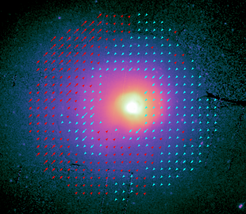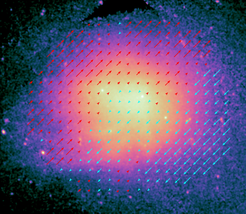First sighting of hot gas sloshing in galaxy cluster
X-ray observatory XMM-Newton shows large scale plasma motion
Using ESA’s XMM-Newton X-ray observatory, scientists led by the Max Planck Institute for Extraterrestrial Physics have identified hot gas sloshing around inside a galaxy cluster – a never-before-seen behaviour that may be driven by turbulent merger events.
Galaxy clusters are the largest systems in the Universe bound together by gravity. They contain hundreds to thousands of galaxies and large quantities of hot gas known as plasma, which reaches temperatures of around 50 million degrees and shines brightly in X-rays. Very little is known about how this plasma moves, but exploring its motions may be key to understanding how galaxy clusters form, evolve and behave.

This image shows the Perseus galaxy cluster – one of the most massive known objects in the Universe – in X-rays, as seen by XMM-Newton’s European Photon Imaging Camera (EPIC). The central region of the cluster can be seen glowing brightly, with its diffuse outer regions extending outwards from the middle of the frame.
The overlaid blue and red arrows show the motion of the gas in the region (relative to the cluster itself), with blue arrows representing gas moving towards us, and red representing gas moving away. The length of the ‘tail’ on the arrows represents the size of the velocity: the longer the arrow tail, the faster the gas is moving.“We selected two nearby, massive, bright and well-observed galaxy clusters, Perseus and Coma, and mapped how their plasma moved – whether it was moving towards or away from us, its speed, and so on – for the first time,” says lead author Jeremy Sanders of the Max Planck Institute for Extraterrestrial Physics (MPE) in Garching, Germany. “We did this over large regions of sky: an area roughly the size of two full Moons for Perseus, and four for Coma.”
The astronomers found direct signs of plasma flowing, splashing and sloshing around within the Perseus galaxy cluster – one of the most massive known objects in the Universe, and the brightest cluster in the sky in terms of X-rays. While this kind of motion has been predicted theoretically, it had never been seen before in the cosmos.
By looking at simulations of how the plasma moved within the cluster, the researchers then explored what was causing the sloshing. They found it to be likely due to smaller sub-clusters of galaxies colliding and merging with the main cluster itself. These events are energetic enough to disrupt Perseus’ gravitational field and kickstart a sloshing motion that will last for many millions of years before settling.

Unlike Perseus, which is characterised by a main cluster and several smaller sub-structures, the Coma cluster contained no sloshing plasma, and appears to instead be a massive cluster made up of two major sub-clusters that are slowly merging together.
“Coma contains two massive central galaxies rather than a cluster’s usual single behemoth, and different regions appear to contain material that moves differently,” says Sanders. “This indicates that there are multiple streams of material within the Coma cluster that haven’t yet come together to form a single coherent ‘blob’, like we see with Perseus.”
Notes
The study uses X-ray observations from XMM-Newton’s European Photon Imaging Camera (EPIC), and data from JAXA’s Hitomi satellite for comparison and elements of calibration.The finding was made possible by a new calibration technique applied to XMM-Newton’s European Photon Imaging Camera (EPIC). The ingenious method, which involved mining two decades of archival EPIC data, improved the accuracy of the camera’s velocity measurements by a factor of over 3.5. This technique made it possible to map the gas in the clusters more accurately.













